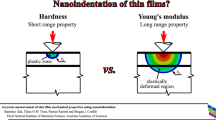Abstract
We reported a simple and convenient method to determine the film thickness by nanoindentation tests. This method starts from the analysis of the unloading portion of the measured nanoindentation load-displacement curves according to a quadratic polynomial, P = α(h - hf)2 - P0, where P is the indentation load, P0 is the virtual load used to consider the effect of the residual contact stress, h is the indenter displacement (penetration depth), hf is the final displacement after complete unloading which should be determined by curve fitting, and a is a constant. Then the best-fit value of the parameter P0 is plotted as a function of the maximum penetration depth, hmax. Such a P0 versus hmax curve may pass through a minimum, and hmax corresponding to this minimum would be equal to the film thickness value.




Similar content being viewed by others
References
W.C. Oliver and G.M. Pharr: An improved technique for determining hardness and elastic-modulus using load and displacement sensing indentation experiments. J. Mater. Res. 7, 1564 (1992).
K. Zeng, E. Soderlund, A.E. Giannakopoulos, and D.J. Rowcliffe: Controlled indentation: A general approach to determine mechanical properties of brittle materials. Acta Mater. 44, 1127 (1996).
M. Sakai, S. Shimizu, and T. Ishikawa: The indentation load-depth curve of ceramics. J. Mater. Res. 14, 1471 (1999).
A.C. Fischer-Cripps: A review of analysis methods for sub-micron indentation testing. Vacuum 58, 569 (2000).
S. Chowdhury and M.T. Laugier: The use of non-contact AFM with nanoindentation techniques for measuring mechanical properties of carbon nitride thin films. Appl. Surf. Sci. 233, 219 (2004).
J. Woirgard and J.C. Dargenton: An alternative method for penetration depth determination in nanoindentation measurements. J. Mater. Res. 12, 2455 (1997).
M. Martin and M. Troyon: Fundamental relations used in nanoindentation: Critical examination based on experimental measurements. J. Mater. Res. 17, 2227 (2002).
G.M. Pharr and A. Bolshakov: Understanding nanoindentation unloading curves. J. Mater. Res. 17, 2660 (2002).
J.H. Gong, H.Z. Miao, and Z.J. Peng: Analysis of the nanoindentation data measured with a Berkovich indenter for brittle materials: Effect of the residual contact stress. Acta Mater. 52, 785 (2004).
Acknowledgment
The authors would like to thank the financial support from Key International Cooperation Project, Ministry of Science and Technology, China (Grant No. 2006DFB51260).
Author information
Authors and Affiliations
Corresponding author
Rights and permissions
About this article
Cite this article
Wen, T., Gong, J., Peng, Z. et al. Determination of the thickness of titanium films on glass substrate by nanoindentation tests. Journal of Materials Research 26, 353–356 (2011). https://doi.org/10.1557/jmr.2010.56
Received:
Accepted:
Published:
Issue Date:
DOI: https://doi.org/10.1557/jmr.2010.56




